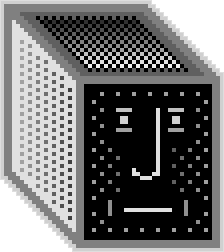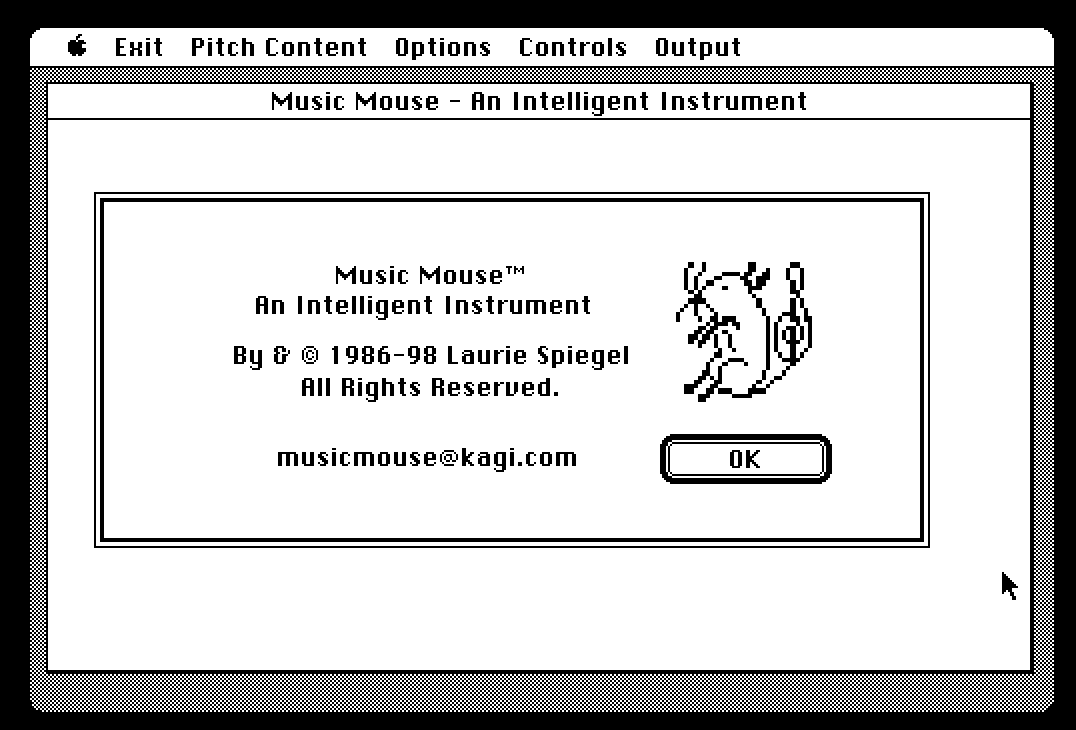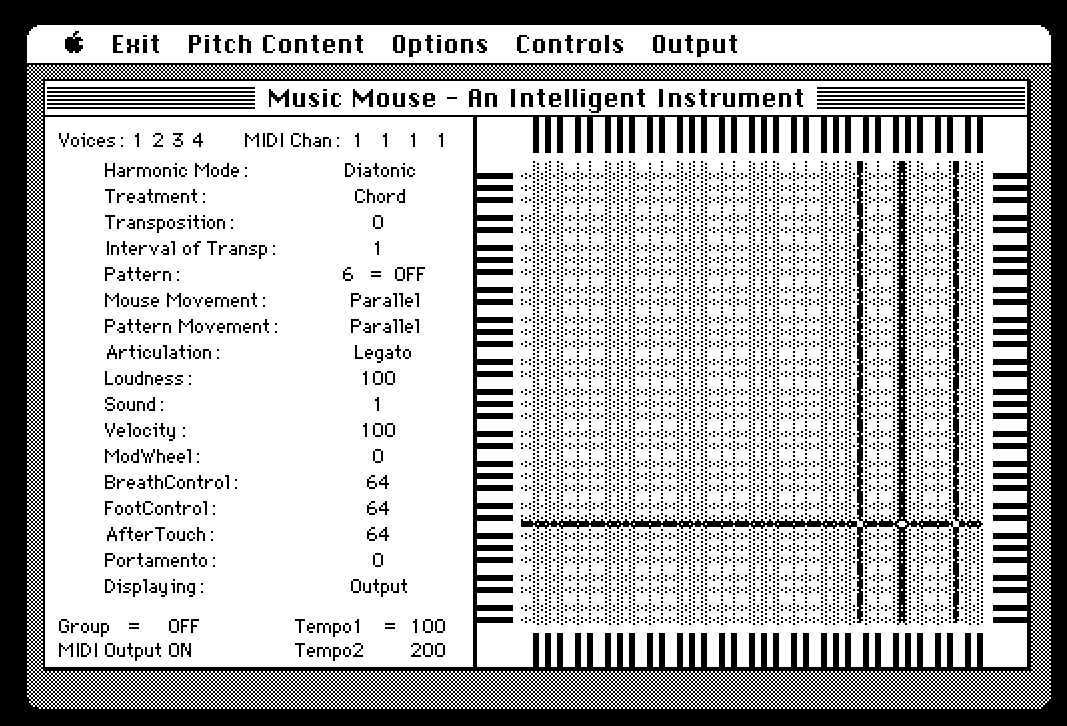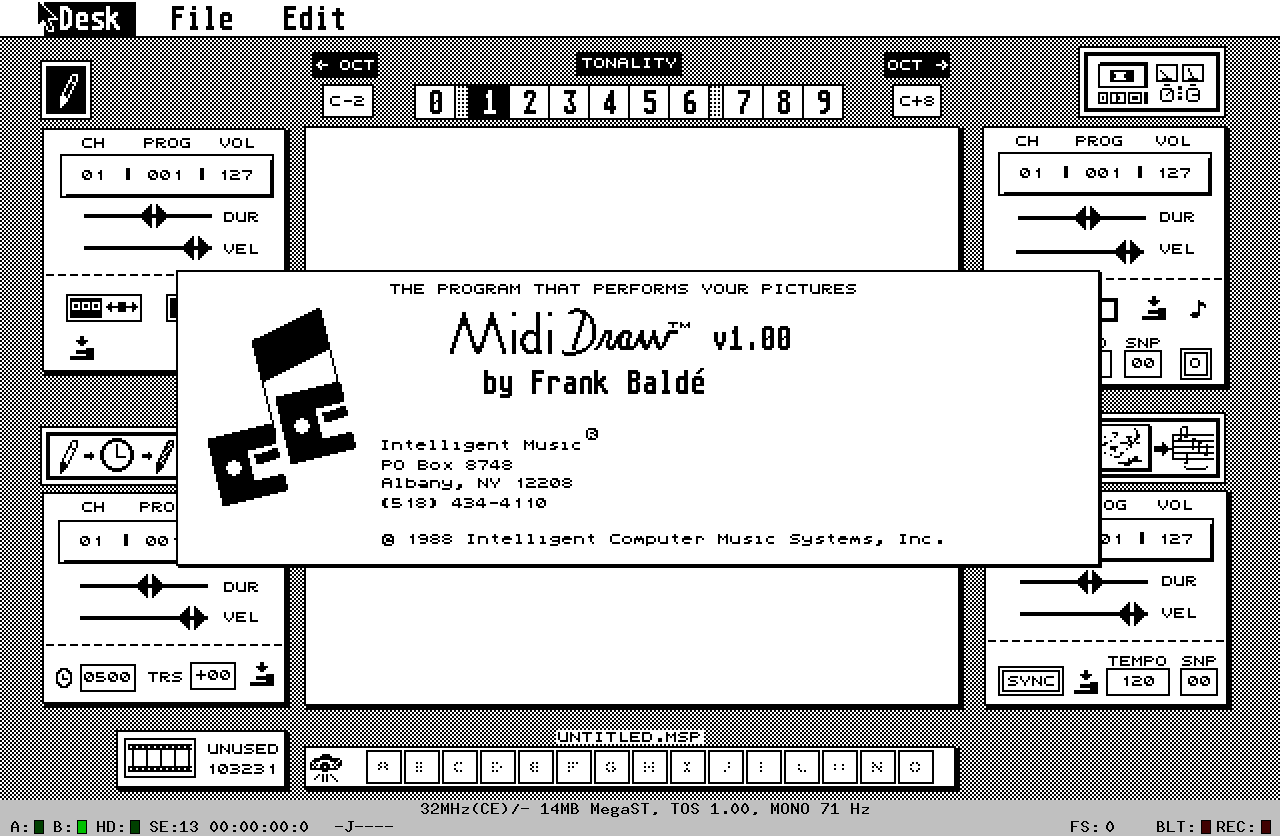Click on albums for bandcamp links
reviews
Background on the albums: Research & Process
In 2020, just prior to the pandemic, I had started digging around on the Internet to find algorithmic midi sequencing software for personal computers from the mid 1980’s into the early 2000’s, with a focus on software for Commodore Amiga, 68k Macintosh, and Atari ST computers. I had been acquiring these old computers for a number of years, and had primarily used them for visual work. Up until this year, I had written off using these computers for the sound work that I do, as my memories of using much of this era of computer were from my first experiences in one of the Electroacoustic studios at Concordia University between 1994-1998. I always had to bring a book with me while long procedures were rendered, as there were no cell phones, and no Internet connection in the lab. I was primarily interested in collaging and stretching sounds that I had made in the analog studios, which had a wall size ARIES modular synthesizer, and reel-to-reel tape recorders. So my earlier experiences with working digitally were riddled with the fact that the computers were very slow to process things that take milliseconds today. I preferred recording to tape, or my cassette four track at home, and didn’t end up buying a computer until almost ten years later. So, this being said, I didn’t realize that there was a whole world of MIDI sequencing software that was just as capable as the programs I now use today.
Before Musical Instrument Digital Interface or MIDI was decided on as the official acronym in 1982, Dave Smith had previously come up with Universal Synthesizer Interface (USI) in 1981. I’ve named this two-volume release after this initial idea. My approach to creating this album has involved research into the birth of MIDI, and the subsequent emergence of intelligent and algorithmic midi sequencing software for early personal computers from around 1985 into the early 2000’s.
Joel Chadabe’s Electric Sound was a great resource; in particular the chapter The MIDI World was very helpful in outlining some hard to find history.
In January of 2019 I found a floppy disk with the Commodore Amiga version of Laurie Spiegel’s Music Mouse on Ebay for a few dollars (the version published by Dr. T’s Music Software in the 1990’s). Music Mouse was one of the first “Intelligent Instruments” for personal computers, which was originally designed as an interactive and playable MIDI sequencer for the 68k era of Macintosh computers in 1985. Unfortunately the Amiga that I had already acquired did not have a MIDI interface, and so in 2020, I found one through an online Amiga group, and started experimenting with Music Mouse. I also contacted Laurie to let her know what I was up to, and to see if she could provide me with other versions of the software. She was very supportive, and sent me a full version of the software that I was able to use on a Macintosh Plus (image below). Laurie seems to be one of the few people with archives of her work that are still accessible on current computers. Even though she went from self-publishing and distributing her software, to publishing through Dr. T’s Music software, and eventually back to self-publishing and distributing, she still has copies of her software available.
A little later into my research, Laurie also sent me an archive of Atari ST midi sequencing software from Tim’s Atari MIDI World Yahoo group archives. Since Yahoo group archives had been disbanded in 2019; I was in search of the files that were missing from some of the websites download links. This was a website set up by an Atari ST enthusiast Tim Conrardry, which still exists and has lots of software available to download, but anything that linked to the yahoo groups archives is now broken. The site remains a relic from the last time it was updated (just before Tim passed away), and looks like websites from the early days of the Internet, full of lots of information but not concerned about design. This archive was a revelation to me, and clued me into the amazing world of software that was created for the Atari ST. In particular, there was a lot of DIY software created in the United States, Germany, the Netherlands and France. This is known amongst Atari ST enthusiasts, but the sheer amount of software that focused on algorithmic and intelligent ways to compose, with randomness being a strong factor in the process was news to me. A lot of the ideas that have come out of this approach to creating electronic music and MIDI sequencing, that have been further developed in more recent programs (like Ableton Live and Max for Live devices that focus on algorithmic and intelligent sequencing) would not have been possible without this foundation of work, that was largely a DIY world of software creation.
One of the DIY programs that I discovered through delving into the Tim’s Atari MIDI World was David Snow’s MIDI Master Drummer (image below). One of the tracks on Volume I was created with this program. David Snow also created several other unique MIDI sequencers and programs for the Atari ST. I have been in touch with David Snow who has continued to compose, and still keeps a link up on his website with links to download his programs for Atari ST. Master Drummer is a rhythmic sequencer, with a nice self generating feature for creating randomized/algorithmic patterns, and multiple midi outputs for each instrument.
Midi Master Drummer for Atari ST
After researching further into the idea of intelligent sequencers and instruments from this era, I was lead to Intelligent Computer Music Systems, or Intelligent Music. Intelligent Music was a small software developer started by Joel Chadabe in 1986 in Albany New York. It focused on unique approaches to MIDI sequencing; that stemmed from Joel’s ideas on computer music composition, and his interest in creating software that would allow users to adjust and tweak their music while a computer was composing it. This approach also had links to some of the work being done in France at IRCAM, and early interactive MIDI experiments that were starting to be developed at the time. After financial difficulties, Intelligent Music sold most of their software rights to be published by Dr. T’s Music Software. Towards 1989-1990 most of their focus went into publishing MAX, first in collaboration with IRCAM, and eventually with Opcode Systems in 1989. Opcode Systems, started by David Oppenhiem, was an early creator of MIDI interfaces for 68k era of Macintosh Computers, and eventually went on to develop some groundbreaking programs such as Opcode Vision. They were also the first company to publish David Zicarelli’s software, which was a DX7 patcher for Macintosh.
I was able to find the Amiga version of Intelligent Music’s M 1.0 (image below) on a UK Amiga group archive, and figured out how to make a version that was bootable from a floppy disk. This was a program developed by David Zicarelli and a few other students of Joel Chadabe (John Offenhartz and Antony Widoff). M is a direct reflection of Joel’s concepts of compositional variables, and the desire to create an intelligent algorithmic compositional tool. There is actually a newish version of this program that is still available through Cycling 74, and used on current Macs with 32 bit compatible OS, but it has a very tiny interface. It’s really satisfying to use the full screen interface on the Amiga, with its intense colour palette (image below). After using M on its own, I then started feeding Music Mouse from the Macintosh Plus (via an Opcode MIDI device), into the Amiga version of M. This allowed me to record the Midi data from Music Mouse, and then randomize and tweak it through M, which was output via midi to Ableton Live on my laptop. This set up was used in a live performance on Radio Tsonami in Chile in the summer of 2020, and is available as a free download on my Bandcamp site.
M for Commodore Amiga
My interest in Intelligent Music software lead me to research some of the programmers who were listed in the ABOUT section of the programs I liked. I cross-referenced some of my favorite software, which lead me to a name that appeared on the programs that I liked the most. Eric Ameres, who was employed by Intelligent Music, and created a unique Atari ST port of M, and was responsible for one of the more complex and multifaceted midi sequencers for Atari ST called Realtime (image below).
Realtime for Atari ST
Eric also worked on one of Frank Balde’s early pieces of gestural midi software for the Atari ST called Diablo (image below), which allows for midi data to be drawn in a window that is much like early paint programs like mac paint. From here you have a number of features that let you record the data into loops, and play with the parameters of the midi notes, as well as take snapshots that can then be clicked between in real time.
Diablo for Atari ST
I had a video chat with Eric, and he informed me of some of the history of Intelligent Music, which was his first programming job out of University. He’s a busy guy, working on a PhD and in his spare time he has created MAX for Live devices that mimic some of the features of Intelligent Music Software from the 80’s. He also let me know about another program called Ovaltune (image below) by David Zicarelli, which has midi-drawing features combined with algorithmic and rhythmic midi sequencing. I was able to dig up a version of Ovaltune from a large archive of software that someone posted on the Macintosh Garden website.
Ovaltune for Macintosh
Around this time I was also in contact with David Zicarelli, who was the director of software development at Intelligent Music (Joel Chadabe was the president). Between 1986-1990 Intelligent Music published several interactive algorithmic midi sequencing programs on all three platforms I have been researching (Macintosh, Amiga and Atari ST) Jam Factory, M, Upbeat, Midi Draw, Realtime, and Ovaltune. Eventually, as I mentioned, due to financial hardships, much of these titles were sold and published by Dr. T’s Music Software in 1990. Unfortunately a lot of David’s work from this era exists on floppy disks and zip drives, all of which is inaccessible to him at this time. It is my hope to eventually receive some funding that might aid in the process to archive any material that hasn’t already. David went on to found Cycling ‘74, which started publishing MAX in 1997. In 2009 Cycling ‘74 merged some of the features of MAX into Ableton Live’s DAW, allowing for MAX for Live to exist. This is an interesting history to track, which really starts with the DIY nature of some of the software that was being created in the late 1980’s into the 90’s. The Current state of Ableton Live, which has merged with Cycling ’74, and the ability to create DIY devices in MAX for Live can be traced to these early roots.
(Images of Jam Factory, upbeat, M and midi draw below)
As I said earlier, one of my favorite programs as of now is Diablo (image below) for the Atari ST by Frank Baldé, which was a very hard program to find a disk image of. I got in touch with Frank, who is most known for his work at Steim in the Netherlands (RIP Steim), to see if he had any archives that were accessible. Unfortunately not a lot of his work from this era of midi sequencers has been archived, and although he still has an Atari ST, much of this work sits on floppy disks. I was able to dig up a version of Diablo from an archive of the Steim website using the Internet Archives Wayback Machine, which amazingly still had software program files attached to the download links. From here I created a floppy disk image through an Atari ST emulator, and got it running on a Mist fpga that was then output to Ableton Live via midi (there are two tracks on Volume I created with Diablo). There were many other interactive MIDI sequencers created by Frank after his early work with the Atari ST, and Midi Draw and Diablo represent some of the early beginnings of this process.
Diablo for Atari ST
Another algorithmic tool that is used on Volume I can be found in early versions of Steinberg’s Cubase for the Atari ST. Cubase started as a MIDI only sequencing program for the Atari ST, and was eventually made available for Mac and PC, with audio editing and VST features added. The Cubase module I use on one of the tracks on Volume I is called the Interactive Phrase Synthesizer (image below), and allows for variations in midi phrases similar to Intelligent Music’s M. It’s a fun tool to add variations to midi patterns that have been recorded in Cubase. As a funny coincidence this album was actually mastered by an old friend of mine, Corwin Fox, with a current version of Cubase that he uses today. Interesting to see how far this software has come since this early version for Atari ST.
Interactive Phrase Synthesizer, from Cubase for Atari ST
And Lastly, I have one track on the Volume I that was created with A.E.X. (image below). This is an algorithmic midi sequencer created by Guido Goebertus (aka Dr. Ambient), from Holland. He is someone that I have yet to get in touch with, and may unfortunately be unreachable. Guido was someone who continued to create programs for the Atari ST into the early 2000’s, and this particular version was created in 2002.
A.E.X. for Atari ST
All of the software that I have been using exists as a single program on a floppy disk (or a disk image that I use with a floppy emulator, or MIST fpga). The computer can only load one program at a time, so no multiple windows or multiple applications open, etc. So keeping this in mind, if I were to put this into todays world, the programs I’m working with are kind of like expanding one single max for live device onto an entire screen, or one VST plugin onto an entire screen. This also means you are limited to just using that one device, and outputting MIDI data from there. There is something really pleasing about this approach, and being limited to the parameters on the screen of an old computer. There are interesting interactive elements as well, some programs have a space to draw in midi notes, or tweak the algorithm with numbers, sliders and mouse positions, or click between saved snapshots in real time.
All of the sounds that I used on the album are a combination of DX-7 sound patches (Sysex files) that were created in the 1990’s (some of which were created by Tim Conrardry) or synthesizers and drum machines that would have existed in this era of music creation. I have used a combination of soft synth replicas and “real” analog synthesizers. I am hoping to have written transcripts of interviews with some of the people I’ve mentioned on the Hotham Sound website in the future, and a second volume of this release available in 2022.

































